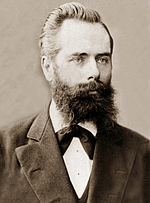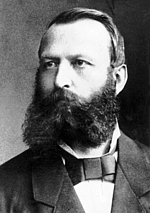History
The foundation of Uhland's "Technicum Mittweida" marks the beginning of the university’s two-year foundation period whose 150th anniversary is now being celebrated from May 2015 to May 2017.
Technicum – Technikum. Dual foundation 1865/67
Over the course of two years – between 2015 and 2017 - Mittweida University is celebrating the 150th anniversary of its establishment as a technical school. The fact that there are two foundation dates relates back to its two founding fathers: Wilhelm Heinrich Uhland and Carl Georg Weitzel.
Uhland was born on 11 January 1840, son of a sawmill owner in Nordrheim (Württemberg) and was trained as a mechanical engineer. After working at several machine factories throughout Germany he took up a new employment in November 1864 as an engineer for the machine factory Oskar Rißmann located in Mittweida’s Bahnhofstraße - across from today's "ZMS" (Centre of Media and Social Affairs, university campus). From December 1864 he was giving speeches about the "construction of steam engines" at Mittweida's Craftsmen Association. This association supported him when he founded Mittweida’s first "Technicum" at the local Theatre in May 1865.
However, in the beginning Uhland's “Technicum" struggled to succeed economically in Mittweida. By the end of April 1867 Uhland relocated to Frankenberg where he founded the "Technikum zu Frankenberg".
That was when Mannheim-based engineer Carl Georg Weitzel, who had already been part of Uhland’s faculty took over the original foundation project in Mittweida. On 7 May 1867 he set up the “Technikum Mittweida” with the support of local personalities. This institution, which he had successfully established as a private school for the training and education of mechanical engineers, soon attracted large numbers of students. Around the turn of the century the "Technikum Mittweida" had become one of the biggest private educational establishments in Germany. At the time, Saxony was leading in the field of mechanical engineering, with one of Germany’s most tightly knit rail networks.
Carl Georg Weitzel realized that the industry needed not only skilled workers and Master craftsmen but also engineers with industrial know-how and experience.
The following decades were marked by the struggle for formal recognition of courses and degrees, trying to gain education political acceptance.
Courses began in 1867 with 17 students, quickly rising to a number of 185 by 1873 so that the previously occupied premises no longer provided sufficient space for teaching. Despite considerable financial difficulties, Carl Georg Weitzel managed to acquire the front part of what was to become the main building - today’s "Carl-Georg-Weitzel" building – and started holding classes there in 1874.
Weitzel’s visionary ideas included setting up laboratories for practical training and introducing subject Electrical Engineering in 1884 were some of the founder's long-term decisions. Two years later electrical lighting equipment was installed in the physics lecture hall for demonstration purposes. Three new halls were constructed for the electrical engineering department in 1890.
Weitzel’s efforts as founder of "Technikum Mittweida" were honoured by the town council of Mittweida with an honorary citizenship and with the title of "Kammerrat" (councillor of the board of domains) by the Saxon king. In the same year, after 25 years of being head of the “Technikum”, he transferred his official duties to Alfred Udo Holzt. All the stress and strain of his time as a headmaster, teacher and author of text books as well as private setbacks had taken a toll on his health.
Alfred Udo Holzt, a young engineer teaching at "Technikum Mittweida", took over management and continued Weitzel's idea of stressing the practical aspect of classes.
New technological developments were instantly picked up by Holzt: from 1909 he offered courses about aviation technology and automotive engineering. As soon as 1917, prospective electrical engineers could take classes in a new subject called "telecommunication and radiotelegraphy". Additionally they were granted access to telecommunication and radiotelegraphy laboratories.
Results of Holzt’s ambitious efforts were the construction of the "Electrotechnisches Institut" - today’s "Alfred-Udo-Holzt" building - opened in 1894 and the launch of the "Lehr- Fabrikwerkstätten" in 1901, which were renamed into "Präzisionswerkstätten Mittweida GmbH" three years later. Here, interns were able to prepare for their studies and electrical machines, measuring instruments, teaching materials and machine tools were produced.
Already in 1902, Alfred Udo Holzt was awarded the title of professor for his work and achievements and that of a Royal Saxon privy councillor in 1917. By the mid-1920s, "Technikum Mittweida" achieved its so far highest number of students with 2300 young people. Visiting students arrived mainly from European countries but also from further overseas. At times more than half of the students were from abroad.
Despite its ongoing popularity and good reputation "Technikum Mittweida" got into financial difficulties towards the end of the 1920s. During the Great Depression the number of students decreased and shutting down the institution seemed inevitable. The crisis was worsened by the private character of the establishment: it opposed political efforts to nationalize all schools.
After the National Socialists' accession to power, continuing "Technikum Mittweida" in the same way as before was no longer possible. From 1935 the title of "Ingenieurschule Mittweida" had to be used. On 15 June 1936 privy councillor Professor Alfred Udo Holzt resigned as head of the institution. After lengthy negotiations it was acquired by a foundation named "Ingenieurschule Mittweida (Höhere Technische Lehranstalt)". On 25 October 1938 management was taken over by national socialists and thus teaching continued until January 1945.
"Ingenieurschule Mittweida" resumed courses in mechanical engineering, electrical engineering, agricultural engineering and automotive engineering on 1 November 1947.
On 1 September 1969 the foundation ceremony for the "Ingenieurhochschule Mittweida" (engineering college) took place: its status ensured equality with technical colleges as well as universities. From 1976 all graduates of the engineering colleges received the title of "Diplom-Ingenieur". In 1980 Mittweida’s engineering college was granted the right to award the doctorate degree of "Doktor-Ingenieur". In 1990, Prof Dr.Eng habil. Reinhard Schmidt was elected headmaster by a large majority of college members. Under his management, the college's preservation could be ensured and a fresh start as " Mittweida University of Applied Sciences" was made possible.
Over the course of this anniversary (2015 to 2017) Mittweida University is going to research and write down its history again, determining three chapters (1933-1945, 1947-1989, 1992-2015) that are to replace the current chronicle at this site. Today, University Mittweida presents itself as a powerful university of applied sciences in Saxony. Five faculties offer study courses to about 7,000 students and conduct research within four different fields.

